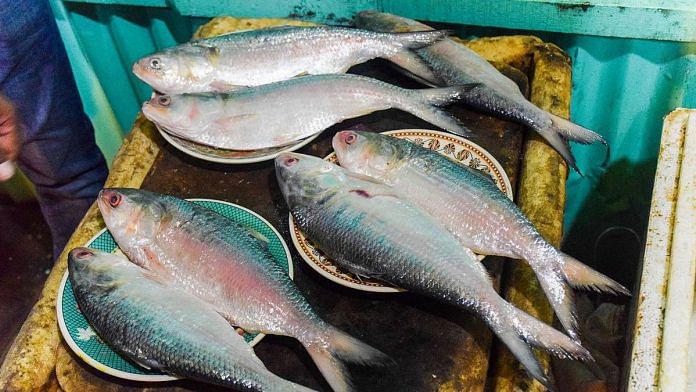New Delhi: Lovers of hilsa, the fish considered a big delicacy in most Bengali households, have some good news to look forward to.
Concerned over the dwindling numbers of the fish in Ganga, the government-run National Mission for Clean Ganga (NMCG) has embarked on an ambitious, technology-aided project to help conserve and increase the natural stock of hilsa in the river.
The NMCG has collaborated with the Barrackpore-based Central Inland Fisheries Research Institute (CIFRI) for Hilsa Improvement Programme, which has been approved for a three-year period to see the visible impact of the initiatives.
The programme will seek to establish the current migration pattern of the fish upstream of Farakka Barrage in West Bengal by tagging the fish with Floy T-bar anchor tags — an external tag put between the fish bones — and other advanced technologies like sensor-based tagging.
“The idea is to identify the breeding location of the hilsa and declare them conservation sites. The project is aimed at establishing the natural biodiversity of the Ganga,” NMCG director general Rajiv Ranjan Mishra told ThePrint over the phone.
A salt water fish, hilsa migrates from Bay of Bengal to the fresh waters of Ganga to spawn. However, various studies, including one by CIFRI in 2017, have found that the number of hilsa in Ganga has dropped in recent years.
One of the primary reasons for this is the construction of the Farakka Barrage on the Hooghly river that has obstructed hilsa’s upstream migration.
Now, the new project will monitor this migration pattern to aid its objectives.
How the hilsa project will work
Under the programme, the CIFRI will ranch the hilsa and then tag them in a move aimed at improving its population in the Ganga river.
Ranching is a type of fish farming where the fish is cultured in confined waters in a controlled laboratory environment and released in the river when they are matured adults.
“We have fixed a target of ranching 30,000 hilsa brooder (matured hilsa ready to breed) in the upper stretches of Ganga above Farakka,” said a senior NMCG official, who didn’t wish to be named.
So far, a total number of 3,274 hilsa brood fish have been ranched. Out of this, 402 brood fish were tagged with Floy T-bar anchor tags and released in the river, said the official.
Also read: PM Modi launches Matsya Sampada Yojana to help double exports of fisheries, create jobs
The CIFRI study
For its 2017 study that was funded by the NMCG, the CIFRI established the first hilsa ranching station on the right bank of Ganga, upstream of Farakka Barrage.
The official said the CIFRI study found that “tagged hilsa were recorded as far as Munger in Bihar”. Besides, juvenile hilsa were also recorded upstream of Farakka barrage.
This was an indication of possible migration of adult hilsa through the barrage for breeding and laying the eggs in the upstream, or self-establishment of native population in the upstream, the study said.
It also found that migration failure is the major cause for decline of hilsa population in the upper stretch of Ganga.
Where is hilsa found?
Hilsa is well distributed in the Ganga-Brahmaputra river systems in India and Bangladesh. In India, these two rivers yield a rich hilsa catch during the monsoon. However, the hilsa catch over the years has declined in the Ganga.
The NMCG official quoted above said a number of factors are responsible for the falling numbers.
These include the construction of barrages across rivers that has obstructed the migration of hilsa to reach its natural breeding ground, high rate of fishing pressure at different life stages of the fish in all the habitats (estuary, river stretches), increase in industrial pollution and domestic pollution flowing into the river and higher rate of sedimentation in rivers, among others.
“These factors have contributed to the loss of their habitat resulting in decline of hilsa catch in the Ganga,” the official said.
This has resulted in illegal smuggling of the prized fish from Bangladesh. It was reported last week that the Border Security Force seized approximately 2,800 kg of Bangladeshi hilsa in the last seven months.
Hilsa from the Padma (Ganga) river in Bangladesh is considered to be tastier compared to the catch in West Bengal.
In 2012, Bangladesh had banned the export of hilsa to India. However, in 2019, the country lifted the ban temporarily during Durga Puja. Last week, the Bangladesh government gave special permission again to its traders to export the fish to India.
Also read: Najafgarh jheel to nala — How Delhi and Gurugram ruined their second-largest waterbody



